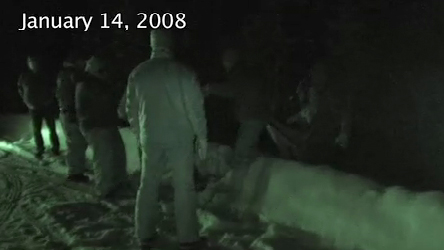2008 April - Solo found dead
Wildlife professionals usually avoid conditions that trigger capture myopathy. The Southeastern Cooperative Wildlife Disease Study newsletter dated January 1994 lists the following suggestions to reduce the occurrence of capture myopathy:
- Only well trained personnel should be included on capture crews.
- Enough people should be on hand to work the animals quickly and effectively; however, inclusion of extraneous personnel should be avoided to reduce additional stress to the animal.
- Noise and movement should be kept to a minimum. Blindfolding the animal may help reduce stress.
- Using trap methods rather than chasing will greatly reduce the animal's level of exertion. If chase is necessary, minimizing the total distance and speed of the chase and setting a maximum chase time are recommended.
- Capture should be avoided on extremely hot days. If animals are captured in hot weather, wetting the skin may help prevent overheating.
- Chemical immobilization can reduce stress to the animal; however, some drugs compound the problems of decreased blood pressure and muscle necrosis, so the type of drug, dosage, and delivery system must be chosen carefully.
- Transport of captured animals also can be a stressful experience. Choosing crates and crate mates appropriately will help minimize this stress. Providing food and water to the animals during transport and while in captivity will help decrease the additional stress of dehydration and hunger.
- When animals are captured and then held in captivity, handling should be minimized for the first 2 to 3 weeks to allow recovery from the initial stress of capture.
 In this case, though, Solo was tracked by a bear dog, drugged, handled by an overly large crew, separated from her cubs, crated and put in a noisy trailer, and taken for a 12-hour drive rather than a 2-hour flight to Michigan. If she and her cubs had simply been placed in the same crate for their long journey to Oswald's she may have survived the ordeal. Those of us who work closely with research bears know the strong bonds that exist between mothers and cubs. It is difficult for us to imagine the stress Solo must have gone through when she woke from the drugs to find she could hear and smell her cubs but not reach them.
In this case, though, Solo was tracked by a bear dog, drugged, handled by an overly large crew, separated from her cubs, crated and put in a noisy trailer, and taken for a 12-hour drive rather than a 2-hour flight to Michigan. If she and her cubs had simply been placed in the same crate for their long journey to Oswald's she may have survived the ordeal. Those of us who work closely with research bears know the strong bonds that exist between mothers and cubs. It is difficult for us to imagine the stress Solo must have gone through when she woke from the drugs to find she could hear and smell her cubs but not reach them.
 While capture myopathy was likely the proximal cause of Solo's death, the ultimate cause of death was misconceptions about our research and black bears in general.
While capture myopathy was likely the proximal cause of Solo's death, the ultimate cause of death was misconceptions about our research and black bears in general.
